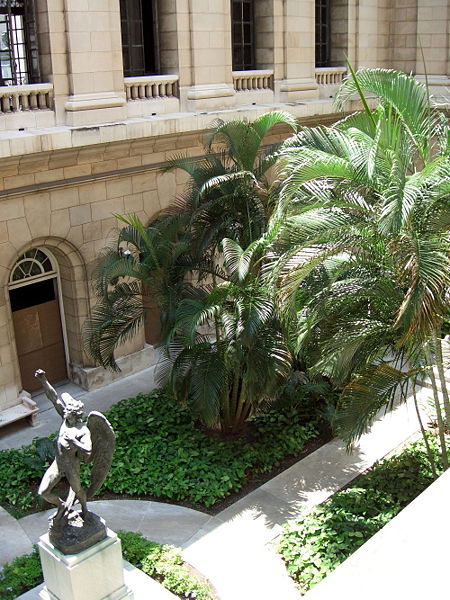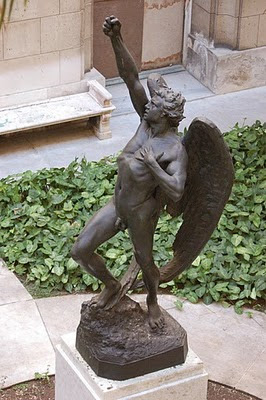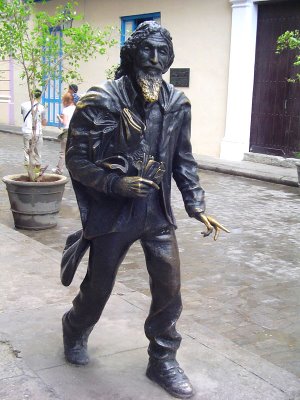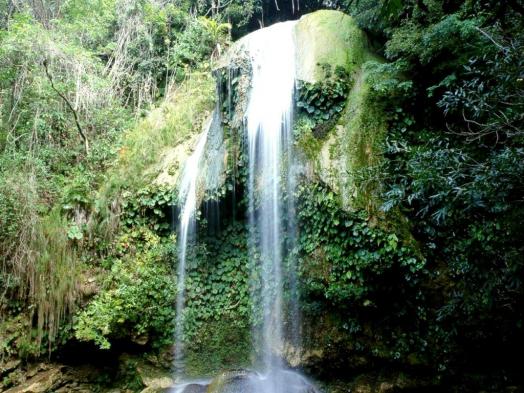THE SCULPTURE OF THE DEVIL IN CUBA NATIONAL CAPITOL.
Havana, capital of legend and charm, of charm and history, of old and new monuments, of famous statues that recreate the look of the attentive and amusing walker that cross its narrow streets and where each figure of bronze and marble has its own history; As our Federico García Lorca would say, the statues of my Havana have an elf and walk through sleepers all over my city.
From Monsieur de Paris to John Lennon, that Liverpool quartet musician today sitting cross-legged on a bench from 17th to 6th street in Havana’s Vedado. But very little has been said about a statue that would come to raise the greatest protest of the past and present divine world of the Cuban blessed and that it did in its Cuban historical moment. “The Statue of the Devil” of the Cuban National Capitol that still remains airy, radiant in one of the inner courtyards of what should be the Palace to make the laws for all Cubans.
Yes, there is a statue of the Devil in Havana. The capital of Cuba is one of the few cities in the world where a monument to Satan, the so-called King of Darkness, was set up.
Its author was the Italian Salvatore Buemi. The sculpture in bronze that as we said is in an inner courtyard of the Capitol. It is smaller in size than the human average and draws the attention of specialists because the figure, far from showing signs of humiliation before the punishment, with which sometimes is usually represented, looks defiant and overbearing.
With a fist raised towards the sky, while he touches the chest with the opposite hand, the Devil of Havana seems to have been caught up in the moment when, erect and haughty, he rebels against the divine power and claims his alleged right to supplant bye.
According to Christian tradition, Satan is the chief of the angels who, before the creation of man, rebelled against God by arrogance and envy, and were hastened to hell.
He personifies evil and is also called the Great Enemy of God, the Tempter, the Prince of Darkness, the Bad. In the New Testament is also called Beelzebub, the Evil One … Much later, Tertullian called him the Monkey of God. By being taken out of heaven and condemned to hell, he is also called the Fallen Angel.
Precisely that is the title that Salvatore Buemi gave to his sculpture, and some saw it as the symbol of discord and controversy.
It is said that the sculptor Buemi, in 1910, presented his work to Orestes Ferrara, who then presided at the House of Representatives, at that time located on the street Oficios corner of Churruca, where later the Ministry of Education was there, Of 1959, and now there is the Hall of the City.
The piece was to be set up at the Capitol in 1931, two years after its inauguration, and when the Italian politician, who had won Colonel’s Stars of War, was ambassador to the dictatorship of Gerardo Machado in Washington.
Where was The Fallen Angel of Buemi during the 21 years since Ferrara received it in gift and its location in the Capitol? Mystery. There is no evidence that he had been stationed in the building of the old House of Representatives, and some sources attribute a long and unconfirmed pilgrimage to public institutions that did not delay in rejecting it.
Ferrara may have preserved the sculpture in his home at that time, in the 27th street at M, in Vedado, in front of Machado’s residence, where he lived before he built the splendid palace of San Miguel and Ronda, on the side of the University habanera. It is also unknown whether Ferrara received the gift in Italy or in Havana.
In any case, The Fallen Angel is the least-respected and least-seen sculpture of all that stands in our old and beautiful national capital and still remains in the place that should be called the Palace of Making the Laws of Cuba in our Capitol National.
Agencies / CiroBianchiRoss / Internet Photos / Excerpts/ Arnoldo Varona / TheCubanHistory.com
THE CUBAN HISTORY, HOLLYWOOD.
FOLLOW US ON TWITTER AND FACEBOOK. THECUBANHISTORY.COM
LA ESCULTURA DEL DIABLO EN EL CAPITOLIO NACIONAL CUBANO.
La Habana, capital de leyenda y hechizo, de encanto e historia, de viejos y nuevos monumentos, de estatuas famosas que recrean la mirada del caminante atento y divertido que recorren sus estrechas calles y donde cada figura de bronce y mármol tiene historia propia; como diría nuestro Federico García Lorca, las estatuas de mi Habana tienen duende y andan de traviesas por toda mi ciudad.
Desde Monsieur de Paris (El Caballero de París) hasta John Lennon, aquel músico del cuarteto de Liverpool hoy sentado con piernas cruzadas en un banco de la calle 17 esquina a 6ª en el Vedado habanero. Pero muy poco se ha hablado de una estatua que vendría a levantar la mayor protesta del pasado y actual mundo divino de los beatos cubanos y que lo hizo en su momento histórico cubano. “La Estatua del Diablo” del Capitolio Nacional Cubano que aun hoy se conserva airoso, radiante en uno de los patios interiores de lo que debería ser el Palacio de hacer las leyes para todos los cubanos.
Si, hay una estatua del Diablo en La Habana. La capital de Cuba es una de las pocas ciudades del mundo donde se emplazó un monumento a Satanás, el llamado Rey de las Tinieblas.
Su autor fue el italiano Salvatore Buemi. La escultura en bronce que como dijimos está en un patio interior del Capitolio. Es de tamaño menor al de la media humana y llama la atención de los especialistas porque la figura, lejos de dar muestras de humillación ante el castigo, con las que a veces suele representarse, luce desafiante y prepotente.
Con un puño levantado hacia el cielo, mientras se toca el pecho con la mano contraria, el Diablo de La Habana parece haber sido atrapado en el momento en que, erguido y altanero, se rebela contra el poder divino y reclama su pretendido derecho a suplantar a Dios.
Según la tradición cristiana, Satanás es el jefe de los ángeles que, antes de la creación del hombre, se rebelaron contra Dios por soberbia y envidia, y fueron precipitados al infierno.
Personifica al mal y se le llama también el Gran Enemigo de Dios, el Tentador, el Príncipe de las Tinieblas, el Malo. En el Nuevo Testamento se le llama además Belcebú, el Maligno… Mucho después, Tertuliano lo llamó el Mono de Dios. Por haber sido sacado del cielo y condenado al infierno, se le llama asimismo el Ángel Caído.
Precisamente ese es el título que dio Salvatore Buemi a su escultura, y algunos la vieron como el símbolo de la discordia y la controversia.
Se dice que el escultor Buemi, en 1910, obsequió su obra a Orestes Ferrara, que presidía entonces la Cámara de Representantes, en aquella época situada en la calle Oficios esquina a Churruca, donde después estuvo el Ministerio de Educación, que permaneció allí hasta después de 1959, y ahora se halla el Salón de la Ciudad.
La pieza se emplazaría en el Capitolio en 1931, dos años después de su inauguración y cuando el avieso político de origen italiano, que había ganado en la Guerra de Independencia las estrellas de Coronel, era embajador de la dictadura de Gerardo Machado en Washington.
¿Dónde estuvo El ángel caído, de Buemi, durante los 21 años que median desde que Ferrara lo recibe en obsequio y su ubicación en el Capitolio? Misterio. No hay constancia de que hubiera estado emplazado en el edificio de la vieja Cámara de Representantes, y algunas fuentes le atribuyen un largo y no confirmado peregrinar por instituciones públicas que no demoraban en rechazarlo.
Quizá Ferrara conservára la escultura en su domicilio de entonces, en la calle 27 esquina a M, en el Vedado —frente a la residencia de Machado— donde vivió antes de que hiciera edificar el espléndido palacete de San Miguel y Ronda, al costado de la Universidad habanera. Se desconoce igualmente si Ferrara recibió el regalo en Italia o en La Habana.
De cualquier manera, El ángel caído es la escultura menos mentada y menos vista de todas las que se erigen en nuestra vieja y bella capital nacional y aun permanece en el lugar que debería ser llamado el Palacio de hacer las Leyes de Cuba, en nuestro Capitolio Nacional.
Agencies/CiroBianchiRoss/Internet Photos/Extractos/ Arnoldo Varona/ TheCubanHistory.com
THE CUBAN HISTORY, HOLLYWOOD.



 THE SCULPTURE of the Devil in Cuba National Capitol. * LA ESCULTURA del Diablo en el Capitolio Nacional Cubano.
THE SCULPTURE of the Devil in Cuba National Capitol. * LA ESCULTURA del Diablo en el Capitolio Nacional Cubano.







